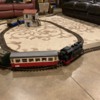For me, I became attracted to LGB when our children were younger. The locos, cars and track were large, colorful, and, came with the implied promise that if I ever adopted an elephant, the elephant likely couldn't damage the track -- at least according to the photo in the catalog! All kidding aside, the size, color, and seeming durability were appealing. I also found that the adult ladies in our family were particularly attracted to the LGB trains and my LGB layout. Finally, I appreciated that the trains could be run outdoors in dry weather (no rain or snow unless precautions were taken for the power source), and that a very large layout could be built so quickly.
As for tinplate, I became far more interested when MTH started producing the trains. As some have noted in other threads, I also enjoy the bright, shiny trains, although that is not an absolute prerequisite. Additionally, I did not have the necessary time, or devotion to the search process likely needed to assemble a roster of vintage tinplate trains and accessories. I do, however, understand and admire the effort put in by those who appreciate and enjoy "the searchin' -- as one author/dealer affectionately refers to "the hunt". Finally, I too love the size and color of tinplate, and equally as important, the historical significance of tinplate to our hobby.
I'm sure that some day, I will take the LGB out of the boxes, and give it a run! Actually running the LGB outdoors with the grandchildren this fall sounds like a fun weekend get together.
Do you have a favorite as between LGN and tinplate? I'll bet that it's tinplate!









